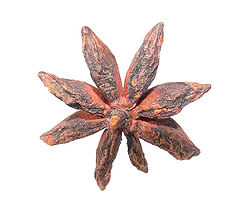 |
|
|
|
|
| Cuisines | Herbal | Spice | Curry | Yeast | Recipe | ||||||
|
Anise Illicium verum, commonly called Star anise, star aniseed, or Chinese star anise, (Chinese: 八角, pinyin: bājiǎo, lit. "eight-horn" or "eight-corners") is a spice that closely resembles anise in flavor, obtained from the star-shaped pericarp of Illicium verum, a medium-sized native evergreen tree of northeast Vietnam and southwest China. The star shaped fruits are harvested just before ripening. Culinary usesStar anise contains anethole, the same ingredient that gives the unrelated anise its flavor. Recently, star anise has come into use in the West as a less expensive substitute for anise in baking as well as in liquor production, most distinctively in the production of the liquor Galliano. It is also used in the production of sambuca, pastis, and many types of absinthe. Star anise enhances the flavour of meat. It is used as a spice in preparation of biryani all over the Indian subcontinent. It is widely used in Chinese cuisine, in Indian cuisine where it is a major component of garam masala, and in Malay and Indonesian cuisine. It is widely grown for commercial use in China, India, and most other countries in Asia. Star anise is an ingredient of the traditional five-spice powder of Chinese cooking. It is also a major ingredient in the making of phở, a Vietnamese noodle soup. In India it is used as an ingredient of masala chai. Medicinal uses Star anise has been used in a tea as a remedy for rheumatism, and the seeds are sometimes chewed after meals to aid digestion. As a warm and moving herb, star anise is used to assist in relieving cold-stagnation in the middle jiao, according to Traditional Chinese medicine. Modern pharmacology studies demonstrated that its crude extracts and active compounds possess wide pharmacological actions, especially in antimicrobial, antibacterial, antioxidant, insecticidal, analgesic, sedative and convulsive activities. It is the major source of shikimic acid, a primary precursor in the pharmaceutical synthesis of anti-influenza drug Tamiflu. Shikimic acid is produced by most autotrophic organisms and whilst it can be obtained in commercial quantities from elsewhere, star anise remains the usual industrial source. In 2005, there was a temporary shortage of star anise due to its use in making Tamiflu. Late in that year, a way was found of making shikimic acid artificially. Roche now derives some of the raw material it needs from fermenting E. coli bacteria. The 2009 swine flu outbreak led to another series of shortages as stocks of Tamiflu were built up around the world, sending prices soaring. Star anise is grown in four provinces in China and harvested between March and May. It is also found in the south of New South Wales. The shikimic acid is extracted from the seeds in a ten-stage manufacturing process which takes a year. Reports say 90% of the harvest is already used by the Swiss pharmaceutical manufacturer Roche in making Tamiflu, but other reports say there is an abundance of the spice in the main regions - Fujian, Guangdong, Guangxi and Yunnan. Japanese star anise (Illicium anisatum), a similar tree, is not edible because it is highly toxic (due to containing sikimitoxin); instead, it has been burned as incense in Japan. Cases of illness, including "serious neurological effects, such as seizures", reported after using star anise tea may be a result of using this species. Japanese star anise contains anisatin, which causes severe inflammation of the kidneys, urinary tract and digestive organs.The toxicity of Illicium anisatum, also known as Shikimi, is caused by its content in potent neurotoxins (anisatin, neoanisatin, and pseudoanisatin), due to their activity as non-competitive antagonists of GABA receptors. |











